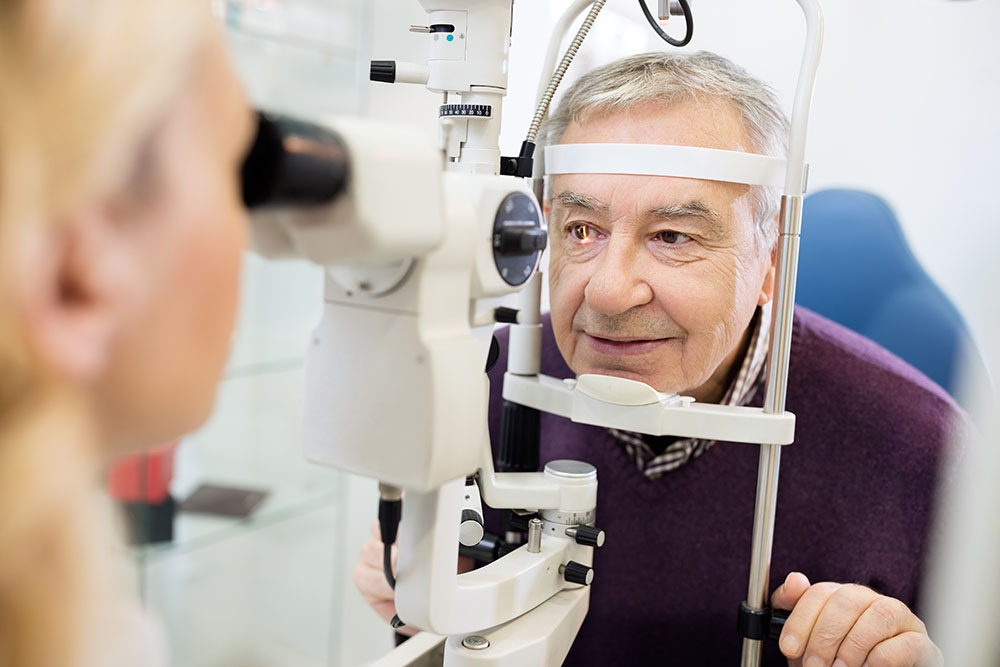Cataracts
What does aging look like? We know that everyone—okay, almost everyone—will gradually develop gray hairs and wrinkles over time.
Well, cataracts are the same way. The truth is that it’s not a matter of if, but a matter of when. They are an essentially inevitable part of the aging process. Initial onset tends to occur around age 60 for most people; by age 80 more than half of Americans will have developed cataracts.
What does that mean for you? Fortunately, there’s good news. By taking care of your vision, getting regular eye exams, and treating cataracts early, you can enjoy healthier and clearer eyesight throughout your life.

What Are the Symptoms of Cataracts?
Cataracts are a progressive condition that gradually clouds and impairs the lenses of your eyes. The normally clear lens becomes visually clouded, often taking a milky appearance.
If you can imagine trying to peer out of a foggy or frosted window, you have a bit of an idea of what cataracts are like.
Early on, symptoms may not be very noticeable, and vision is not functionally impaired to a significant degree. However, as they get worse, your cataracts will begin to create obstacles in your daily life:
- Clouded or blurry vision—may start in just one spot but grow to cover more of your visual field
- Dim vision that especially impairs your ability to see at night
- Oversensitivity to light and/or glare, or seeing “halos” around lights
- Loss of ability to read, drive, or perform other tasks requiring sharp vision
What Causes Cataracts?
The lenses of your eyes are made from a delicate mix of proteins, which give them their transparent and flexible structure.
Unfortunately, those proteins slowly (but surely) degrade over time. The proteins start to clump together, changing the structure of the lens tissue. This makes it thicker, and cloudy instead of clear.
Although there’s no way to fully prevent this natural part of the aging process, certain factors can increase your risk of earlier cataract development. These include:
- Certain genetic disorders
- Diabetes
- Long-term steroid use
- Sunlight exposure
- Previous eye injuries or surgeries
- Smoking
- Alcohol abuse
How to Manage and Treat Cataracts
As with any progressive condition, it’s best to catch cataracts early—before the symptoms begin to interfere with day-to-day living. If you’re over age 60 or already wear glasses or contacts, you should probably be getting a comprehensive eye exam every 1-2 years.
If symptoms are not yet severe, we can prescribe or recommend non-surgical treatments or modifications to help you maintain a high quality of life. It will be important to get your eyes checked frequently so we can monitor how rapidly the cataracts are progressing, as well as make sure you maintain the most accurate possible prescription for your glasses or contacts
Additionally, we may recommend tools and trucks such as using a magnifying lens for reading, adding a reading lamp or buying brighter light bulbs, and wearing good sunglasses and a wide-brimmed hat while you’re outside.
Once vision loss has deteriorated to the point where you can’t safely maintain your desired lifestyle, cataract surgery will need to be considered.
The good news here is that cataract surgery overall has a high rate of success, regardless of how severe your cataracts are.

Get Help Today!
Your eyes are a truly irreplaceable resource and critical for nearly everything you do. Don’t put off seeing your eye doctor if something is bothering them! To schedule an appointment with Dr. Zuraida Zainalabidin, please call (520) 585-5717 today.
Contact Us
Office Hours:
Monday - Friday
8:00AM - 5:00PM
By Appointment Only:
First Saturday of the month from 8:00AM - 2:00PM
